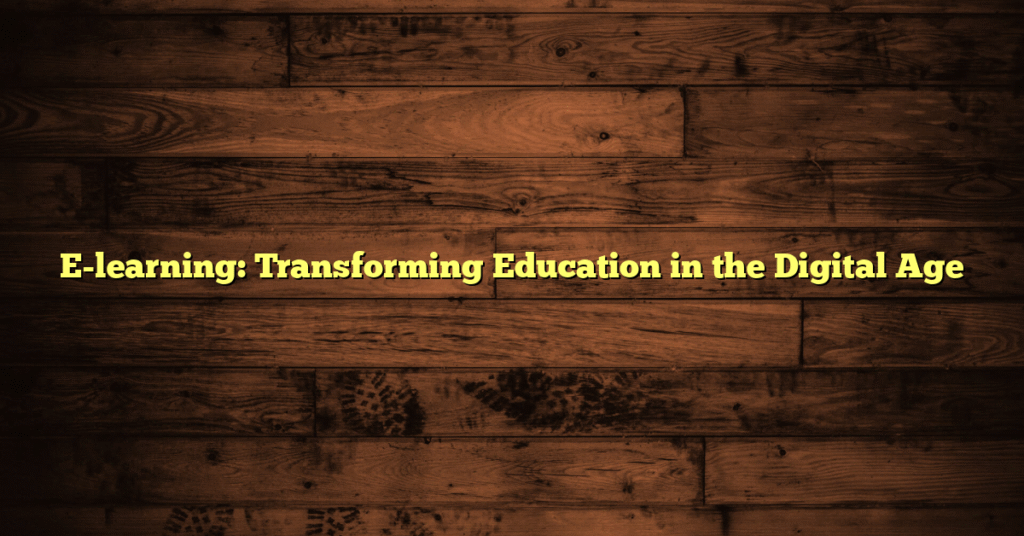In an interval outlined by fast technological developments, e-learning stands at the forefront of instructional innovation. The digital classroom has modified commonplace strategies, making teaching further accessible and customised than ever before. As we delve into the intricacies of e-learning, it becomes evident that this system is not solely a pattern, nonetheless a transformative shift that redefines how we purchase data. Be part of us as we uncover the assorted sides of e-learning and its profound impact on teaching through the digital age.
The Rise of E-Discovering: A Historic Perspective
The evolution of e-learning is probably traced as soon as extra to the arrival of the web in the late twentieth century. Initially, digital teaching was restricted to elementary online purposes, but fast technological enhancements have since expanded its horizons. From multimedia reveals to trendy Discovering out Administration Systems (LMS), the alternatives options obtainable as we converse have revolutionized the tutorial landscape.
Key Milestones in iE-Discovery’s Evolution
-
- Nineties: Emergence of Online Discovery platforms
-
- Early platforms, just like the School of Phoeni, paved the way for online teaching.
-
- Nineties: Emergence of Online Discovery platforms
-
- 2000s: Enhancement of LMS
-
- Methods like Moodle and Blackboard grew to become widespread, offering structured frameworks for e-learning.
-
- 2000s: Enhancement of LMS
-
- 2010s: MOOC Revolution
-
- Huge Open Online Packages (MOOCs) democratized entry to high-quality teaching, permitting a lot to enroll in courses offered by prestigious institutions like Harvard and Stanford.
-
- 2010s: MOOC Revolution
-
- 2020s: Distant Discovering out Progress
-
- The worldwide pandemic accelerated the adoption of e-learning, making it a mainstream mode of teaching.
-
- 2020s: Distant Discovering out Progress
Understanding E-Discovering: What It Encompasses
E-learning is an umbrella time interval that choices various modes of online teaching. Its flexibility in format caters to a couple of studying varieties and preferences. Listed below are the first types of e-learning:
1. Synchronous E-Discovering out
-
- Entails hold online lessons, the place educators and college students work collectively in real-time. Units reminiscent of Zoom and Microsoft Groups facilitate this model, selling engagement and speedy options.
2. Asynchronous E-Discovering out
-
- Permits college students to test at their own pace, providing access to recorded lectures, online bforumsand pre-recorded materials. This format is especially widespread amongst working professionals looking to upskill.
3. Blended Discovering
-
- Combining common-place face-to-face classroom strategies with online digital media creates further built-in learning expertise.
4. Microlearning
-
- Focuses on delivering content materials in bite-sized segments, making studying further digestible and tailor-made to busy lives.
5. Gamification
-
- Incorporates recreation components into studying actions, enhancing engagement, and making the technique even better.
The Advantages of E-Discovering
The transformation launched by e-learning is underscored by a few advantages that improve the teaching experience:
1. Accessibility and Flexibility
One among many compelling benefits of e-learning is its accessibility. School school college students can entry belongings from wherever, anytime, breaking geographical boundaries. This flexibility permits learners to tailor their teaching to their schedules.
2. Value-Atmosphere pleasant
E-learning reduces tutorial prices considerably. College students save on commuting, lodging, and supplies, making high-quality teaching even more priced.
3. Personalised Discovering out Expertise
Online platforms use data analytics to trace pupil progress, enabling custom-made options and tailor-made evaluation plans. This fosters deeper understanding and retention of information.
4. Quite a few Course Choices
School college students can choose from an infinite array of purposes, from house of curiosity subjects to specialised expertise, catering to express explicit individual pursuits and occupation targets.
5. Advantages for Educators
Instructors can reach a broader audience and profit from ingenious teaching strategies. Using multimedia contributes to a further dynamic study atmosphere.
Challenges in E-Discovering
Whereas e-learning is a game-changer, it does embrace its set of challenges. Recognizing these hurdles is important for developing pleasant digital learning methods.
1. Technological Boundaries
Not all college students have access to high-speed internet or the required facilities. This digital divide can hinder the efficacy of e-learning.
2. Motivation and Self-discipline
Online learners typically require a higher degree of self-motivation. The dearth of face-to-face interaction would possibly lead to feelings of isolation, impacting engagement.
3. High-quality Administration
With the proliferation of online purposes, guaranteeing high-quality and credibility becomes a problem. College students should discern dependable sources from subpar content materials.
4. Evaluation Integrity
Online assessments are prone to dishonesty and inaccuracies, raising concerns about the reliability of examination strategies.
E-Discovering Units and Utilized Sciences
The success of e-learning largely depends on the units and sciences employed. Listed below are some revolutionary decisions reworking the digital teaching landscape.
1. Discovering out Administration Methods (LMS)
Platforms like Canvas and Schoology set up and ship course content materials and supplies effectively, enabling seamless interplay between school educators.
2. Video Conferencing Units
Options reminiscent of Zoom and Google Meet facilitate holding lessons, bridging the gap between physical and digital classrooms.
3. Collaboration Units
Platforms like Slack and Discord promote collaboration amongst school students by way of discussion boards and group projects.
4. Evaluation and Analysis Units
Online quizzes and exams, facilitated by way of platforms like Kahoot and ProProfs, guarantee interactive evaluation strategies.
5. Content material materials supplies Creation Units
Tutorial belongings are probably developed utilizing units like Canva and Adobe Spark, permitting educators to supply engaging course materials.
The Means forward for E-Discovering out
As we glance forward, the e-learning panorama is poised for added evolution. Listed underneath are some traits which is probably inclined to form the long run:
1. Synthetic Intelligence
AI will personalize the tutorial expertise by analyzing data, recommending belongings, and providing real-time options.
2. Augmented and Digital Actuality (AR/VR)
These utilized sciences can create immersive learning experiences, permitting college students to explore topics interactively.
3. Social Discovering out
The mixing of social media in teaching can foster group engagement and peer-to-peer studying, enriching the e-learning experience.
4. Knowledge, Privacy, and Safety
With elevated digital interplay, the emphasis on safeguarding pupil data will rise, prompting establishments to undertake stringent safety measures.
Conclusion: Embracing the E-Discovering Out Revolution
E-learning is not solely an alternative; it’s an essential evolution in teaching. As know-how continues to advance, the challenges will inevitably hold, nevertheless, as they provide an opportunity for development improvement. For each school school college students and educators, the important issue to thrive in this digital panorama lies in adaptability and common learning.
Actionable Insights for School and College Students and Educators
-
- For college students: Embrace self-discipline and create a loyal evaluation house to boost focus. Work together actively in dialogue boards and search assistance when needed.
-
- For Educators: Leverage a couple of e-learning units fairly to boost the course present. Sometimes, alternative supplies are needed to maintain their relevance, and include mechanisms to gauge student understanding.
The digital age invites us to rethink teaching, and e-learning is at the heart of that transformation. By embracing these choices and addressing its challenges, we’re able to unlock a future the place teaching is not solely a privilege, nonetheless a normal right. Let’s step into this new realm of studying collectively!



